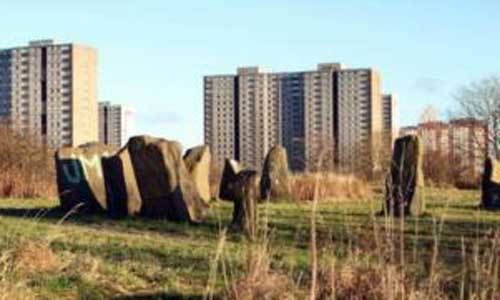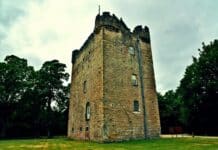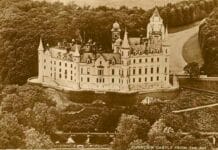Sighthill Park in Glasgow has one of Britain’s newer but no less significant stone circles, says MJ STEEL COLLINS

Think ‘stone circle’, and Stonehenge probably comes to mind, not a hilltop of Sighthill Park in a rundown part of North Glasgow. In 1979, the first stone circle to be built in Britain in around 3,000 years was constructed here by the Glasgow Parks Astronomy Project as part of the city’s Jobs Creation Scheme.
Dedicated to astronomers Archie Roy, Euan MacKie, Alexander Thom and his son Archie Thom, the Sighthill Park Stone Circle was designed and laid out by author and astronomer Duncan Lunan, with the help of Gavin Roberts, the sadly departed John Braithwaite and Joan Coles.
Sighthill Park Stone Circle uses 17 stones
The Sighthill Park Stone Circle was quite an endeavour, using 17 specially selected stones from Beltmoss Quarry in Kilsyth. The project was never completed thanks to the new government of 1979. Mrs Thatcher was unimpressed with what she called ‘nonsense’, and work was immediately stopped. Apart from landscaping that reduced the original height of the stones in 1982, the circle has been lying untouched ever since.
Not that it isn’t loved. Interest in the circle has been growing in recent years, and it’s popular with locals and tour groups alike. It’s also the focus of a campaign to save it. Development and Regeneration Services have earmarked the site for a walkway as part of Glasgow’s bid for the 2018 Youth Olympics. A better fate than this, surely, is deserved by a stone circle built according to the rules of ancient astronomy. Its creator, Duncan Lunan, explains:
“The original brief was to build a copy in modern materials of either Stonehenge or Callanish, in one of the city’s parks. I had to persuade the Parks Dept. and the Manpower Services Commission that it was on the wrong latitude, the tilt of the Earth’s axis has altered, so have the rising and setting positions of the stars, and the markers had to be lined up with the events at the actual horizon of the site.
“Having won that argument, I then proposed to build a working, present-day astronomical circle in stone, as a tribute to the Thoms, Euan Mackie and Archie Roy, experts in ancient astronomy all closely connected with the city.
“The layout is based on the view points surrounding Le Grand Menhir Brisé in Brittany. On Prof. Thom’s advice, the larger stones mark the lunar alignments and were erected by the Parks contractors; the solar solstice stones, star stones dating the monument and the central stone were then flown into place by a Royal Navy Sea King helicopter from HMS Gannet at Prestwick. Two of the spares were to support a plaque, and two to be outliers to mark equinoctial sunrise and sunset.
“Funding to renovate and complete the circle was agreed with the City Council in 2001, but action was postponed because of social problems in the area. Meanwhile Arts Depot have arranged two major events with schools in the area this year, and my book “The Stones and the Stars: Building Scotland’s Newest Megalith” has just been published. I really thought the circle’s time as an educational feature and visitor attraction was coming at last. But hundreds of people are signing Mandy’s petition to save the circle: big names include Prof. John Brown, Astronomer-Royal for Scotland, astro-artist David Hardy, and Stuart Braithwaite of Mogwai, John’s son. There’s real hope that we can do it.”








Ah, Thatcher the megalithic stone snatcher!
Great article, Paul